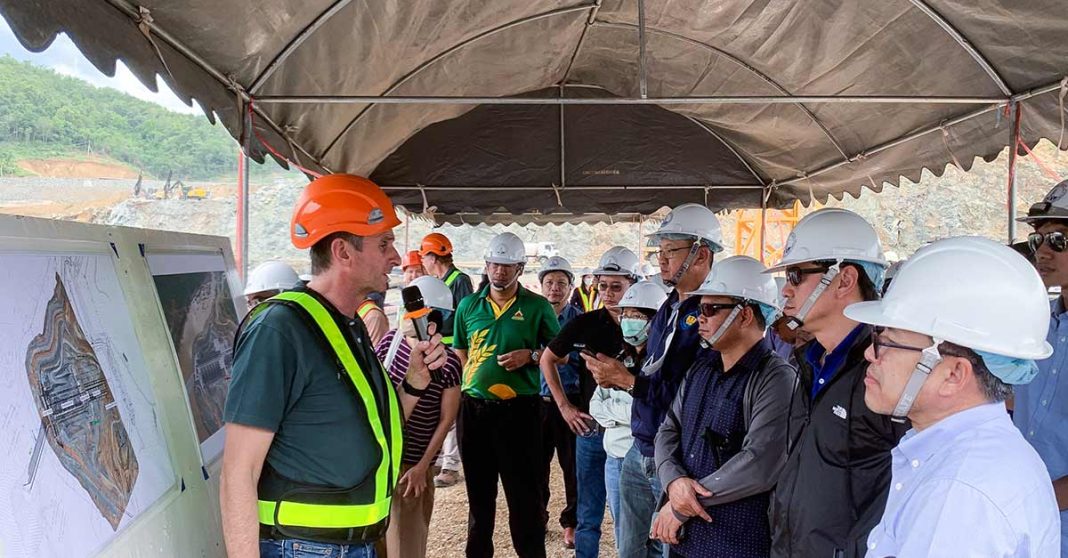The Lao government welcomed a Mekong River Commission delegation last week to showcase the development progress of its third Mekong mainstream hydropower project.
While senior officials and experts from the MRC Member Countries and Secretariat expressed appreciation, they urged the Lao government and the developer of the Luang Prabang dam to officially share the project data and information with their fellow governments and the public more broadly.
The call came out during the “Regional Workshop on the Implementation of the Joint Action Plan (JAP) of the Luang Prabang Hydropower Project” on 21–22 June in Luang Prabang, which grew out of the Prior Consultation process for the project.
Construction at the 1,460-megawatt Luang Prabang dam is ongoing. The developer — Luang Prabang Power Company Limited — expected that river flow to the downstream ecosystem and communities would be unaffected, which they said should remain the norm for the next four-five years of construction. The MRC delegation also visited the Xayaboury hydropower project, which has the same owner and operator as that of the Luang Prabang project.
In fact, the site visit to both dams came amid a broader push by the MRC and its four Member Countries for greater accountability, transparency, data sharing and public engagement. The 2020 JAP came on the heels of a six-month Procedures for Notification, Prior Consultation and Agreement (PNPCA) process: all stakeholders, including riverine activists and community representatives, could express their views on a major infrastructure project that could disrupt their lives. Indeed, during the visit, some members of the national delegations openly expressed ongoing concerns about transboundary and cumulative impacts of dam development. From their experiences, they said they had observed unusual flow fluctuation and a declining fish population.
In 2020, the MRC Joint Committee Statement about the JAP called on “the Government of Laos to make every effort to address any potential transboundary adverse impacts of the Luang Prabang project”.
“We’re here to have a dialogue with the government and the developer on some key concerns with this project, such as fish, sediment transport and dam safety,” said the CEO of the MRC Secretariat, Dr. Anoulak Kittikhoun, against the backdrop of the construction site. “We can see that a lot of efforts have been put in place to address these concerns.”
For example, hydropower dams are generally known to affect fish migration and spawning habits. So, at the Xayaboury project, the MRC had recommended that the developer and Laos significantly improve the fish entrance and passage facilities, including submerging them during all water-flow situations and increasing flow attraction. The fish passage design was then revised.
That seems to have made a meaningful difference. During the 21 June field trip to Xayaboury, the delegation learned more about preliminary fish monitoring results: 86% of the fish successfully migrated through the specially constructed facilities. Of the 1,345 fish detected in the area, 1,156 reportedly ascended.
Yet, long-term monitoring is being conducted to further investigate the efficacity of the fish-migration facilities. The developer said it had been working with European and Australian experts, among others, on this testing and monitoring.
In addition, the developer said after three years of Xayaboury dam operation and monitoring, it had not observed any significant sediment trapping in the impoundment and that the sediment routing facility had allowed the sediment to flow through the turbine and sometimes get flushed through the lower outlets. This is necessary to maintain the river’s natural sediment flow in this stretch of the Mekong.
Besides, during the 22 June field trip to the Luang Prabang dam, the visiting delegation learned about the other actions that Laos and the developer had taken so far to address the MRC’s recommendations.
As the dam is about 25 km upstream of the historic, world-famous city of Luang Prabang, safety is a key concern. It was reported that an independent, dam-safety review panel had already been established before construction began. Per the MRC’s advice, the developer also updated the design of the structures, following site-specific Probabilistic and Deterministic Seismic Hazard Assessment, Probable Maximum Flood (PMF), Probable Maximum Precipitation (PMP) analysis, and dam break analysis – all of it in accordance with the Lao national standards and international good practices.
On fish, the Luang Prabang developer adopted what appears to be working in Xayaboury and added an upstream migration lock at the right bank.
In addition to Lao regulation and MRC’s recommendations, the developer reported on the implementation of International Finance Cooperation (IFC) Performance Standards, including those relating to the assessment and management of environmental and social risks, biodiversity conservation, sustainable management of living natural resources, and cultural heritage.
A Thai member of the delegation – whose country shares hundreds of kilometers of the Mekong with Laos – expressed appreciation to the Luang Prabang developer for openly discussing the progress and plans. Dr. Tuantong Jutagate, Associate Professor of Ubon Ratchathani University, said the developer addressed “our concerns and what we worry about.”
Yet, just as public communication can ease concerns, he said less transparency may also fuel suspicions.
“We want them to know that data sharing is a very important step to make the project more understandable between the developer and the people,” said Dr. Jutagate. “Information is power. If they can share more data about the management of flow and fish, then we can find something in the middle to negotiate and solve any problems.”



